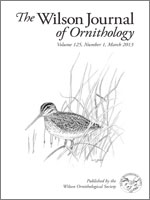We monitored territory density, nest density, date of nest initiation, nest height, and associated vegetation characteristics of Marsh Wrens (Cistothorus palustris) in two marshes managed with herbicide in late summer 2009 to control Phragmites. Average territory density declined fourfold from 2.39 to 0.54 territories/ha (one-tailed t-test, P = 0.004), and average active nest density declined tenfold from 1.43 to 0.12 nests/ha (one-tailed t-test, P = 0.055) between 2009 and 2010. The mean date of nest initiation was twice as late in 2010 (21 Jul) as in 2009 (15 Jun), one-tailed t-test, P = 0.009. Mean nest height was similar (one-tailed t-test, P = 0.20) in 2009 (86.4 cm) and 2010 (79.6 cm), but the vegetation took longer to reach these heights in 2010, particularly at Old Woman Creek National Estuarine Research Reserve. These results suggest large scale aerial herbicide applications to manage Phragmites compromised productivity of Marsh Wrens in the coastal marshes studied. Caution should be used when considering broadcast, aerial applications of herbicides to treat Phragmites in habitats of marsh-dependent, declining, avian species.
How to translate text using browser tools
1 March 2013
Impacts of Phragmites Management on Marsh Wren Nesting Behavior
Mark A. Lazaran,
Carol I. Bocetti,
Robert S. Whyte
ACCESS THE FULL ARTICLE
herbicide application
Marsh Wren
nesting behavior
Phragmites





